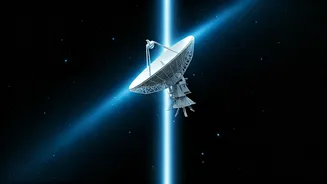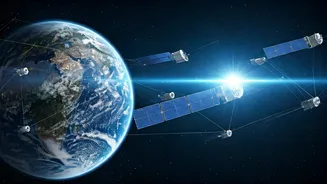Quantum's Cosmic Journey
The research team successfully demonstrated the transfer of quantum light signals from a ground-based station to a satellite orbiting Earth. This was a critical
step in overcoming atmospheric interference, which is a significant challenge when transmitting data. Quantum light, characterized by the use of photons in a quantum state, is extremely sensitive to disturbances and therefore easily disrupted by atmospheric factors. The team employed advanced technologies to mitigate these challenges, ensuring the signal integrity. The experiment utilized entangled photons, where two photons become linked, and the state of one instantaneously influences the other, regardless of distance. By transmitting one of the entangled photons to space, scientists were able to measure the properties of the other photon on the ground. This method successfully established a link demonstrating the transmission and detection of quantum states across the vastness of space. This represents an important milestone, as it proves quantum communication is feasible in the difficult environment of outer space.
Securing Future Communications
This achievement opens a gateway to building highly secure communication networks on a global scale. Quantum communication uses the principles of quantum mechanics to encrypt data in a way that is fundamentally unbreakable. Any attempt to eavesdrop on a quantum signal would inevitably alter the quantum state, alerting the sender and receiver to the presence of an intruder. The ability to transmit quantum light to space provides a more secure way to create highly encrypted, long-distance communication channels. This is especially useful for sensitive information, such as government communications or financial transactions. Space-based quantum communication systems could cover large areas and circumvent the vulnerabilities of terrestrial communication systems. Furthermore, it is expected that by utilizing space-based technologies, communication will become available across multiple distances, from short ones to those between continents and planets. Space-based quantum communication can be a game-changer for information security.
Beyond Communication: New Horizons
The ability to beam quantum light to space does not only improve communications; it also enables the development of new and advanced technologies. For example, it could boost the precision of scientific instruments. Quantum sensors, which are extremely sensitive to minute changes in their environment, could use quantum light to enhance their measurement capabilities. These sensors could be used for various purposes, including weather forecasting, Earth observation, and fundamental physics research. Space-based quantum technologies can also play a role in developing new types of computers. Quantum computers utilize the principles of quantum mechanics to process information in a fundamentally different way than classical computers. They have the potential to solve complex problems that are currently intractable for even the most powerful supercomputers. By combining space and quantum technologies, scientists can advance the field of quantum computing and discover a whole new range of possibilities.
Overcoming the Challenges
Beaming quantum light to space is not without challenges. One of the primary issues is the impact of atmospheric turbulence. The Earth's atmosphere distorts light signals, which affects the sensitivity of quantum states. To overcome this, the researchers used adaptive optics to correct for these distortions, ensuring the signal is strong. Another challenge is the need for highly precise alignment between ground stations and satellites. To ensure the photons travel the intended distance, extremely precise pointing and tracking systems are needed. The development of reliable quantum light sources and detectors also proves challenging. These devices must be robust and capable of operating in the extreme conditions of space. Furthermore, protecting the quantum light signal from disruption by other light sources, is a crucial concern that the scientists needed to take into account. Overcoming these challenges required a multidisciplinary approach, blending expertise in physics, engineering, and computer science.
A Quantum Future
This breakthrough represents more than just a technological achievement; it also signifies a significant step forward in our understanding of quantum mechanics. It allows for advanced research on the behavior of quantum systems. As the technology continues to mature, we can anticipate more efficient and reliable quantum communication systems. The impact will be global, with applications spanning from secure communications to climate monitoring, and even potentially, faster computing. Further exploration of quantum technologies could open up even more possibilities that we haven't even conceived of yet, including more advanced space exploration. This advancement marks a new era in the application of quantum principles, one where the seemingly impossible is becoming reality.












